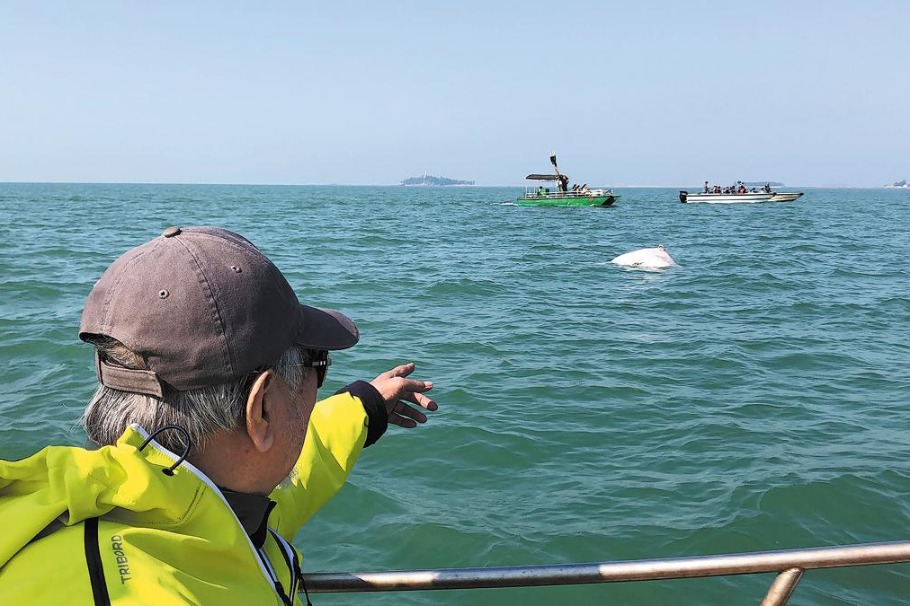Xianbin Reef: Manila's provocation will end in failure


One of the Philippine Coast Guard vessels deliberately rammed a Chinese ship despite repeated warnings from the Chinese side early Monday morning in waters near Xianbin Reef. Later, the Philippine vessels illegally intruded into the waters of Ren'ai Reef, according to the China Coast Guard (CCG).
The repeated provocations by the Philippine side have seriously infringed upon China's sovereignty and damaged peace and stability in the region, said CCG spokesperson Gan Yu. Gang urged the Philippines to immediately cease such provocations or bear full responsibility for any resulting consequences.
The BPR Teresa Magbanua (MRRV-9701), one of the Philippine Coast Guard's largest ships, has illegally stayed in Xianbin Reef for more than a hundred days. In addition, the Philippines has also dispatched the fishery administration ship "Datu Pagbuaya" and organized fishing boats to intrude into Chinese waters.
Looking at the recent actions of the Philippine government on the Xianbin Reef issue, it is not difficult to see what their motives are. Manila has long been trying to occupy Chinese islands and reefs in the Nansha Qundao (also known as Nansha Islands), with different cover-ups and excuses. Encouraged by the Biden administration, Manila's South China Sea policy is becoming more adventurous and speculative. Following the illegal ruling of the South China Sea arbitration, the Philippines has been attempting to endorse its illegal claims and provocations in the South China Sea.
Xianbin Reef is part of China's Nansha Qundao and is not an exclusive economic zone of the Philippines. The patrol and enforcement of Chinese military and coast guard vessels, as well as the activities of Chinese fishing boats in the waters near Xianbin Reef is in accordance with China's domestic law and international law, including the United Nations Convention on the Law of the Sea. As pointed out by the Chinese authorities, the Philippine's behavior seriously violates China's sovereignty and the Declaration on the Conduct of Parties in the South China Sea (DOC) and poses a serious threat to peace and stability to the region.
As China's inherent territory, Xianbin Reef is an uninhabited reef in the Nansha Qundao. The area of the reef is larger than that of Ren'ai Reef, reaching 84 square kilometers, and the central part of the reef is a lagoon with the maximum depth reaching 33 meters. Except for a small number of sandbanks and reefs above the water surface in the western part, all other reef flats are submerged. China Coast Guard vessels are constantly on duty in the waters around and within the reef.
Xianbin Reef and its surrounding waters is also a traditional fishing ground for Chinese fishermen, who have been engaged in fishery production for a long time. Since the outcropping reef resembles fish scales, Chinese fishermen call the reef "yulin" (fish scale). In the early 90s, China also temporarily built stilt houses on the reef and sent personnel to conduct scientific studies.
The Philippines' MRRV-9701 has more than 60 soldiers in service, staying in the middle of the lagoon in Xianbin Reef, where the water depth is about 20 meters. Considering that the ship's self-holding ability is only 15 days, the Philippines has been rotating personnel and providing material supplies through another smaller patrol ship. In the past four months, in addition to the rotation and material supplies, Manila also held a flag-raising ceremony on board and brought "marine scientists" and reporters to Xianbin Reef. The Philippines' personnel also interfered with the marine scientific work of China in the west part of the reef.
Since the second half of last year, the Philippines has been hyping up the issue of Xianbin Reef before it dispatched a coast guard vessel to illegally intrude into the reef. The Philippine Coast Guard, the National Security Council, and the West Philippine Sea Task Force have deliberately slandered Chinese activities and released a lot of disinformation in an attempt to mislead the international community, including claiming that Chinese fishermen are destroying the marine ecological environment of Xianbin Reef, andthat China is planning to carry out land reclamation and construction on Xianbin Reef.
However, the images and videos released by the China Coast Guard clearly showed that the Philippine side not only supplied a large number of daily necessities to the vessel, but also used cranes to move concrete and other construction materials. Behind these actions is the ambition of the Philippines to encroach on China's territory. The purpose of this move is clear: first, the Philippines uses the MRRV-9701 as a transit point for its construction supplies to the warship grounded at Ren'ai Reef and wants to deliver supplies from Xianbin Reef to Ren'ai Reef at midnight to evade the China Coast Guard, so as to improve transportation efficiency. Second, the Philippines is trying to achieve de facto control over the reef through the long-term berthing of the vessel. In Manila's view, the ship could also provide supplies to other official ships and organize Philippine fishing boats as a transit station, and as long as the MRRV-9701 does not leave, more and more Philippines' fishing boats would come to this water area to "fish".
The Philippines' actions at Xianbin Reef have close ties to the United States. Not long ago, the commander of the Pacific Region of the United States Coast Guard visited Manila and held in-depth discussions with the Philippine Coast Guard to strengthen cooperation between the two sides in maritime security. While Philippine media reports did not mention the sensitive content of the discussions between the two sides, the photos released by the Philippines sent a subtle message. The screen behind the US-Filipino participants showed a map of the location from Palawan Islands to Xianbin Reef, with the location of the reef marked with a red box. This reflected the fact that during the meeting between senior US and Philippine coast guard officials, the two sides at least discussed or shared the activities of the Philippine Coast Guard and other vessels at Xianbin Reef. It can also be speculated that the US may give targeted advice or guidance to the Philippine side at tactical level, or other forms of support, including information and intelligence sharing. After the talks, the US officials also boarded the Philippine Coast Guard vessel BPR Melchora Aquino (MRRV-9702) anchored in the port of Manila.
It is worth noting that recent information shows that the Philippines is planning to send MRRV-9702 to the waters of Xianbin Reef. Prior to August 16, the AIS signals indicated that the vessel was stationed at the Manila Port, but on August 17, it abruptly turned off the AIS signal, indicating that it had left the port and was moving toward Xianbin Reef. There are several possibilities for the tasks of the MRRV-9702. The first would be to replace MRRV-9701, which has been in the lagoon of Xianbin Reef for up to four months, which is a kind of mission rotation. The second would be to anchor side-by-side with MRRV-9701 in the in the lagoon of the reef to form a semi-permanent outpost to maintain its illegal presence. The third would be to load large quantities of daily supplies, fresh water, oil, and construction materials to supply MRRV-9701 and other Philippine vessels illegally stranded at Xianbin Reef. From the perspective of on-site control and the ability to safeguard rights and stability, no matter how the Philippines stirs up trouble at Xianbin Reef, it will not counter China's effective response and disposal capabilities.
In addition to violating China's territorial sovereignty, the Philippines' move also violates the DOC. The fifth paragraph of the DOC provides that the parties undertake to exercise self-restraint in the conduct of activities that would complicate or escalate disputes and affect peace and stability including, among others, refraining from action of inhabiting on the presently uninhabited islands, reefs, shoals, cays, and other features and to handle their differences in a constructive manner. Xianbin Reef falls within the scope of "uninhabited features" of this provision. As a member of ASEAN, the Philippines participated in the entire consultation process of the DOC. It should therefore be very clear what the obligations under paragraph 5 of the DOC were and why they were so provided. Without faithful implementation of the DOC, the values of the DOC would be diminished and eroded. In this sense, China's countermeasures against the Philippines' violation of paragraph 5 referred to Xianbin Reef issue is not only based on the need to safeguard its territorial sovereignty, but also out of the need to maintain the seriousness and authority of the DOC.
China will not allow the Philippines to do whatever it wants on Xianbin Reef. The interaction and confrontation between China and the Philippines over the South China Sea issue over the past two years have also fully proved that whether the Philippines adopts the so-called gray zone strategy at sea, the so-called exposure strategy in public opinion, or wants to promote compulsory arbitration on environmental issues at the legal level, Manila will never achieve its goal.
Ding Duo is the deputy director and an associate research fellow at the Research Center for Ocean Law and Policy, the National Institute for South China Sea Studies. Zhong Hui is an assistant researcher at the Division of International Exchanges, the National Institute for South China Sea Studies, and the secretary at the China-Southeast Asia Research Center on the South China Sea. The views don't necessarily represent those of China Daily.
If you have a specific expertise, or would like to share your thought about our stories, then send us your writings at opinion@chinadaily.com.cn, and comment@chinadaily.com.cn.
































